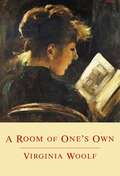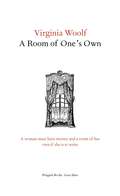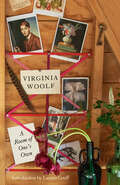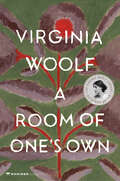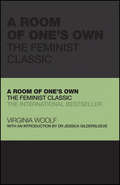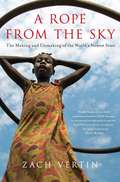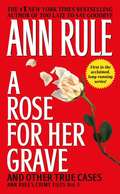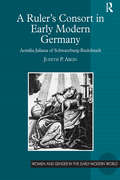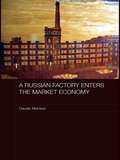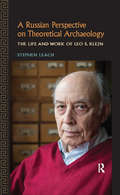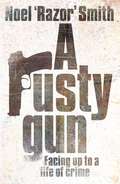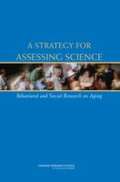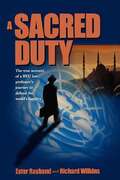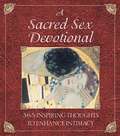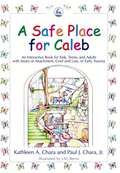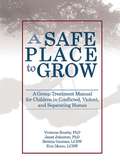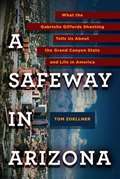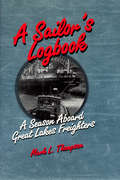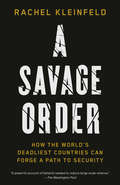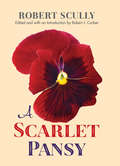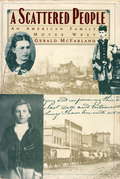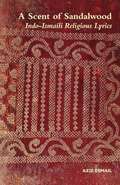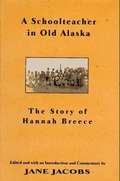- Table View
- List View
A Room of One's Own (Penguin Classics)
by Virginia WoolfA Room of One's Own is an essay based on a series of lectures Virginia Woolf delivered at Cambridge University in 1928. The argument she makes in this pioneering work of feminism is that in order to excel as artists women writers require both a literal and a figurative space they can claim as their own.
A Room of One's Own (Penguin Great Ideas)
by Virginia WoolfThroughout history, some books have changed the world. They have transformed the way we see ourselves - and each other. They have inspired debate, dissent, war and revolution. They have enlightened, outraged, provoked and comforted. They have enriched lives - and destroyed them. Now Penguin brings you the works of the great thinkers, pioneers, radicals and visionaries whose ideas shook civilization, and helped make us who we are.
A Room of One's Own (Vintage Classics)
by Virginia WoolfVirginia Woolf&’s classic plea for a world in which women are free to use their gifts is as powerful and resonant as ever.In this influential extended essay, Virginia Woolf outlined what women need in order to fully make use of their abilities. Using powerful images and memorable thought experiments--such as a fictional sister of William Shakespeare, who is as talented as her brother but limited in ways he was not--Woolf analyzes the many ways in which women have been held back throughout history and still are in her own time. First published in 1929, A Room of One's Own has been a towering and inspirational statement of feminist principles for nearly a century--and remains relevant now, at a time of growing awareness of the kind of social injustices that she decried.
A Room of One's Own: Large Print (Penguin Classics)
by Virginia WoolfAn essay written on the topic of society, women, and fiction.
A Room of One's Own: The Feminist Classic (Capstone Classics)
by Virginia WoolfDiscover Virginia Woolf's landmark essay on women&’s struggle for independence and creative opportunity A Room of One's Own is one of Virginia Woolf's most influential works and widely recognized for its extraordinary contribution to the women's movement. Based on a lecture given at Girton College, Cambridge, it is one of the great feminist polemics, ranging in its themes from Jane Austen and Charlotte Brontë to the silent fate of Shakespeare's gifted (imaginary) sister, and the effects of poverty and sexual constraint on female creativity. The work was ranked by The Guardian newspaper as number 45 in the 100 World's Best Non-fiction Books. Part of the bestselling Capstone series, this collectible, hard-back edition of A Room of One&’s Own includes an insightful introduction by Jessica Gildersleeve that explains the book's place in modernist literature and why it still resonates with contemporary readers. Born in 1882, Virginia Woolf was one of the most forward-thinking English writers of her time. Author of the classic novels Mrs Dalloway (1925) and To the Lighthouse (1927), she was also a prolific writer of essays, diaries, letters and biographies, and a member of the celebrated Bloomsbury Set of intellectuals and artists. Discover why A Room of One's Own is considered among the greatest and most influential works of female empowerment and creativity Learn why Woolf's classic has stood the test of time. Make this attractive, high-quality hardcover edition a permanent addition to your library Enjoy an insightful introduction by Jessica Gildersleeve, who connects the themes of the text to the concerns of today's audience Capstone Classics brings A Room of One's Own to a new generation of readers who can discover how Woolf's book broke new artistic ground and advanced the position of women writers and creatives around the world.
A Rope from the Sky: The Making And Unmaking Of The World's Newest State
by Zach VertinA remarkable chronicle of America’s attempt to forge a nation from scratch, from euphoric birth to heart-wrenching collapse. <P><P> The birth of South Sudan was celebrated the world round—a triumph for global justice and the end of one of the world’s most devastating wars. The Republic’s historic independence was acclaimed not only by its long-oppressed people, but by three U.S. presidents and the legions of Americans who championed their cause. But the celebration would not last; South Sudan’s freedom-fighters soon plunged their new nation back into chaos, shattering the promise of liberation and exposing the hubris of their American backers. <P><P>Drawing on extraordinary personal stories of identity, liberation, and survival, A Rope from the Sky tells an epic story of paradise won and then lost. Zach Vertin’s firsthand accounts from deadly war zones to the halls of Washington power bring readers on an extraordinary journey into the rise and fall of the world’s newest state. South Sudan’s untold story is a unique episode in global history—an unprecedented experiment in international state-building, and a cautionary tale. <P><P>Where Team of Rivals meets The Last King of Scotland, this gripping narrative follows an unlikely cast of liberators as they crusade from the bush to the palace and back. Long darlings of the West, South Sudan’s guerillas were backed by an unprecedented coalition of Democrats and Republicans, ideologues and activists, evangelical Christians and Hollywood celebrities. This zealous alliance helped deliver an oppressed people from tyranny, only to watch in horror as their chosen heroes then turned their guns on each other. <P><P>A Rope from the Sky is propelled by characters both inspired and ordinary their aspirations are matched by insecurities, their sins by courage and kindness. It is first a story of hope, power, greed, compassion, and conscience-shocking violence from the world’s most neglected patch of territory. But it is also a story about the best and worst of America both our big-hearted ideals and our difficult reckoning with the limits of American power amid a world in disarray. <P><P>From moonlit battlefields and glitzy hotel ballrooms to the emerald green marshes of the Nile, A Rope from the Sky is brilliant and breathtaking, a modern-day Greek tragedy that will challenge our perspectives on global politics.
A Rose For Her Grave And Other True Cases (Ann Rule's Crime Files #1)
by Ann RuleAnn Rule's Crime Files books have delivered the very best in true crime reading since A Rose for Her Grave, first in the acclaimed series, made its debut. Distinguished by the former Seattle policewoman's razor-sharp eye for telling detail and her penetrating analysis of the criminal mind, this gripping collection of accounts drawn from her personal files features the twisting case of Randy Roth, who married -- and murdered -- for profit. In her trademark narrative style, Ann Rule weaves a tale that is riveting, enraging, and heartbreaking all at once, and brilliantly chronicles the fateful confluence of a killer and his female victims, as well as the shattering investigation into Roth's heinous crimes.
A Ruler’s Consort in Early Modern Germany: Aemilia Juliana of Schwarzburg-Rudolstadt (Women and Gender in the Early Modern World)
by Judith P. AikinThe wives of rulers in early modern Europe did far more than provide heirs for their principalities and adornment for their courts. In this study, Judith Aikin examines the exceptionally well-documented actions of one such woman, Aemilia Juliana of Schwarzburg-Rudolstadt (1637-1706), in order to expand our understanding of the role of ruler’s consort in the small principalities characteristic of Germany during this period. Aikin explores a wide range of writings by her subject, including informal letters to another woman, hundreds of devotional song texts, manuscript books both devotional and practical, and published pamphlets and books. Also important for this study are the plays, paintings, and musical works that adorned the court under Aemilia Juliana’s patronage; the books, poems, and sermons published in her honor; and the massive memorial volume printed and distributed soon after her death. This material, when coupled with the more scanty record in official documents, reveals the nature and scope of Aemilia Juliana’s role as full partner in the ruling couple. Among the most important findings based on this evidence are those related to Aemilia Juliana’s advocacy for women of all social classes through her authorship and publications, her support for the education of girls, her efforts to ameliorate the fear and suffering of pregnant and birthing women, and her contributions to female support networks. In examining the career of a consort whose various activities are so well documented, this study helps to fill in the blanks in the documentary record of numerous consorts across early modern Europe, and serves as a model for future research on other consorts at other courts.
A Ruler’s Consort in Early Modern Germany: Aemilia Juliana of Schwarzburg-Rudolstadt (Women and Gender in the Early Modern World)
by Judith P. AikinThe wives of rulers in early modern Europe did far more than provide heirs for their principalities and adornment for their courts. In this study, Judith Aikin examines the exceptionally well-documented actions of one such woman, Aemilia Juliana of Schwarzburg-Rudolstadt (1637-1706), in order to expand our understanding of the role of ruler’s consort in the small principalities characteristic of Germany during this period. Aikin explores a wide range of writings by her subject, including informal letters to another woman, hundreds of devotional song texts, manuscript books both devotional and practical, and published pamphlets and books. Also important for this study are the plays, paintings, and musical works that adorned the court under Aemilia Juliana’s patronage; the books, poems, and sermons published in her honor; and the massive memorial volume printed and distributed soon after her death. This material, when coupled with the more scanty record in official documents, reveals the nature and scope of Aemilia Juliana’s role as full partner in the ruling couple. Among the most important findings based on this evidence are those related to Aemilia Juliana’s advocacy for women of all social classes through her authorship and publications, her support for the education of girls, her efforts to ameliorate the fear and suffering of pregnant and birthing women, and her contributions to female support networks. In examining the career of a consort whose various activities are so well documented, this study helps to fill in the blanks in the documentary record of numerous consorts across early modern Europe, and serves as a model for future research on other consorts at other courts.
A Russian Factory Enters the Market Economy (Routledge Contemporary Russia and Eastern Europe Series #Vol. 11)
by Claudio MorrisonThis book charts the experiences of a textile enterprise in Russia during the 1990s, analysing post-Soviet management and managerial practices in order to illuminate the content, nature and direction of industrial restructuring in the Russian privatised sector during the years of economic transition. Based on extensive factory-level fieldwork, it focuses upon changes in ownership, management and labour organisation, unveiling the complex texture of social, communal and gender relations in the workplace over an extended period of time, including through crisis and bankruptcy, acquisition by new capitalist owners and attempted restructuring. It argues, contrary to dominant Western managerial theories which blame the failure of transition on the irrationality of Russian managerial strategies, that the rationale for the continued reliance on Soviet era managerial practices lay in the peculiar form of social relations in the workplace which were characteristic of the Soviet system. It engages with key issues, often neglected in the literature, such as social domination, power and conflict, that capture the problematic and open-ended character of social and economic transformation in post-Soviet production. It demonstrates that far from a simple transition to a market economy, the post-Soviet transition has reproduced most of the features of the old Soviet system, including its patterns of labour relations.
A Russian Perspective on Theoretical Archaeology: The Life and Work of Leo S. Klejn
by Stephen LeachBoth the work and the life of Leo S. Klejn, Russia’s foremost archaeological theorist, remain generally unrecognized by Western scholars. Until now. In this biography and summary of his work, Stephen Leach outlines Klejn’s wide-ranging theoretical contributions on the place and nature of archaeology. The book details-Klejn’s diverse work on ethnogenesis, migration, Homeric studies, pagan Slavic religion, homosexuality, and the history of archaeology;-his life challenges as a Russian Jewish scholar, jailed for homosexuality by the KGB and for his challenges to Marxist dogma;-his key contributions to theoretical archaeology and, in particular, Klejn’s comparisons between archaeologists and forensic scientists.
A Rusty Gun
by Noel 'Razor' SmithAs a gun-wielding bank robber, Noel 'Razor' Smith was top of the criminal tree, enjoying the excitement and benefits of a dangerous and adrenalin-filled career. But he'd also spent the greater part of his adult life in prison, an environment where respect and basic survival were guaranteed only to those prepared to use the most brutal violence. In his new book, Smith takes the story on from his highly acclaimed memoir A Few Kind Words and a Loaded Gun, and describes how he came to realize that the game wasn't worth the candle. In his mid-forties he applied to enter Grendon, then the only prison in Britain offering intense therapeutic treatment to hardened criminals. He went from a brutal high-security prison, HMP Whitemoor, to an institution where he was encouraged to investigate just why his life had been given over to violence and crime. Smith paints an unforgettable portrait of the hardened and severely damaged inmates of Grendon, many of them guilty of famous crimes, and their attempts to turn round their lives. And in particular his own arduous five-year journey to re-enter society as a straight citizen.
A STRATEGY FOR ASSESSING SCIENCE: Behavioral and Social Research on Aging
by National Research Council of the National AcademiesA Strategy for Assessing Science offers strategic advice on the perennial issue of assessing rates of progress in different scientific fields. It considers available knowledge about how science makes progress and examines a range of decision-making strategies for addressing key science policy concerns. These include avoiding undue conservatism that may arise from the influence of established disciplines; achieving rational, high-quality, accountable, and transparent decision processes; and establishing an appropriate balance of influence between scientific communities and agency science managers. A Strategy for Assessing Science identifies principles for setting priorities and specific recommendations for the context of behavioral and social research on aging.
A Sacred Duty
by Ester RasbandRecounts the exciting true story of how Richard Wilkins, as a delegate at an important UN conference, used the principles of the First Presidency's proclamation to defend the traditional family against a vigorous, modern-day attack. This engaging account offers readers an example of how the gospel and devoted individuals can affect the course of history and changes the hearts of humanity.
A Sacred Sex Devotional: 365 Inspiring Thoughts to Enhance Intimacy
by Rafael LorenzoA year's worth of sacred and sensual quotations to inspire and renew love's fires.• Spans the world's cultures and religious traditions.• An invaluable resource for couples following the path of Tantric spirituality.What has happened to the language of lovers? Where are the rich, sensual, erotic, and alluring words that can describe our feelings and emotions? For centuries in cultures throughout the world there have been poetic and evocative words used to express the ecstatic feelings that men and women share in that marvelous and mysterious moment of being in love. For people who want to find their way back to that moment, this book contains inspirations that reveal the sacred tradition of ecstasy in love and sexuality. This celebration of love contains a vast and diverse body of writings on sacred sexuality from Aboriginal Australia, Celtic Ireland, India, Japan, and China to ancient Greece and Rome and Renaissance and Enlightenment Europe. This treasure trove exalting the powers of love will kindle the fires of romance and offer playful and profound ways to contact the divine through earthly love.
A Safe Place for Caleb: An Interactive Book for Kids, Teens and Adults with Issues of Attachment, Grief, Loss or Early Trauma
by Paul J. Chara Jane M. Berns Kathleen A. CharaA Safe Place for Caleb is a comprehensive and richly illustrated resource for individuals of all ages who are dealing with attachment problems. Parents, professionals, and lay people will find this book helpful in understanding and addressing attachment disorders in children, adolescents, and adults. The first half of the book is an interactive story that follows the experiences of Caleb, a young boy who relates his difficulties and frustrations in forming and sustaining healthy relationships. He learns strategies for coping with attachment issues during his journey to the Safe Tree House, where he is introduced to the four 'attachment healing keys'. These act as therapeutic tools to unlock difficulties with attachment, and are presented using text and illustrations that are easily accessible for readers of all ages, even for young children. The second half of the book presents a summary of current scientific thought on attachment styles and disorders, and provides a wide array of assessment tools, photocopiable material and healing techniques to address attachment difficulties. Lists of helpful organizations and relevant reading materials are also presented. Based on established psychological principles, the book is a unique and imaginative guide for professionals, parents, caregivers, and people of all ages who are dealing with attachment issues.
A Safe Place to Grow: A Group Treatment Manual for Children in Conflicted, Violent, and Separating Homes
by Erin Moore Vivienne Roseby Janet Johnston Bettina GentnerDiscover the effective group treatment strategies that help your school-aged clients! A child immersed in a conflicted family life may be forced to cope with a multitude of trauma, including violence, abuse, and insecurity. In A Safe Place to Grow: A Group Treatment Manual for Children in Conflicted, Violent, and Separating Homes, highly respected experts give mental health professionals the tools to provide effective group treatment for children scarred by family environments of conflict and abuse. This easy-to-understand, step-by-step manual is a developmentally appropriate treatment curriculum for traumatized school-aged children. Age-appropriate sections separate therapy for big or little kids, focusing on efficacy while presenting a comfortable multi-ethnic, multi-cultural model. A Safe Place to Grow has easy-to-understand descriptions of techniques, with each session in the curriculum containing games and activities that are therapeutic yet flexible enough to be modified whenever the situation warrants. A chapter is included to helpfully troubleshoot problems encountered when in session with either age group of children. Useful illustrations accompany the text, along with a comprehensive bibliography listing additional therapeutic resources for different types of family problems. Appendixes are included for instruction on psycho-educational groups for parents that enhance their sensitivity to their children&’s needs, as well as providing an evaluation study of the group model itself.A Safe Place to Grow provides a sequence of activities within the group model aimed at each of these five goals: creating common ground and safety exploring the language and complexity of feeling defining and understanding the self defining and revising roles and relationships restoring a moral orderA Safe Place to Grow is an essential resource for social workers, psychologists, family and child therapists, school counselors, and battered women and children&’s advocates.
A Safe Place: The True Story of a Father, a Son, a Murder
by Lorenzo CarcaterraFrom the book: I was fourteen, walking on a beach in Ischia, a Mediterranean island forty miles off the coast of Naples, when I found out about my father. A white cotton towel hung around my neck, the morning sun warmed my back and soft waves rolled against a pea-green fishing boat. A cluster of children were building sand castles by the shore while three German tourists nodded in approval. It was mid-July 1969, my first summer away from home and the most peaceful time in my life. My mother, slumped and weary, stood at my side, staring out to sea. She hardly noticed the Moroccan merchant who was offering good buys on cheap goods or the beach bum selling cool slices of fresh coconut. She reached for my hand, her brown eyes softened by the passing years. "It's time you knew the truth," she said. "About your father." ...
A Safeway in Arizona
by Tom ZoellnerA riveting account of the state of Arizona, seen through the lens of the Tucson shootings On January 8, 2011, twenty-two-year-old Jared Lee Loughner opened fire at a Tucson meet-and-greet held by U.S. Representative Gabrielle Giffords. The incident left six people dead and eighteen injured, including Giffords, whom he shot in the head. Award-winning author and fifth generation Arizonan Tom Zoellner, a longtime friend of Giffords's and a field organizer on her Congressional campaign, uses the tragedy as a jumping-off point to expose the fault lines in Arizona's political and socioeconomic landscape that allowed this to happen: the harmful political rhetoric, the inept state government, the lingering effects of the housing market's boom and bust, the proliferation and accessibility of guns, the lack of established communities, and the hysteria surrounding issues of race and immigration. Zoellner's account includes interviews with those directly involved and effected, including Arizona's controversial Sheriff Joe Arpaio. Zoellner offers a revealing portrait of the Southwestern state at a critical moment in history- and as a symbol of the nation's discontents and uncertainties. Ultimately, it is his rallying cry for a saner, more civil way of life
A Sailor's Logbook: A Season Aboard Great Lakes Freighters
by Mark L. ThompsonIn this firsthand account of life aboard the ships of the Great Lakes, Mark Thompson weaves together the threads of a story that relives a centuries-old tradition. Thompson began his logbook after he reported for duty aboard the Calcite II at Fraser Shipyard in Superior, Wisconsin, for the 1996 shipping season. A Sailor's Logbook is the first such book to chronicle a sailor's life at the end of the twentieth century. Not just a detailing of weather, cargo, and crew relations, A Sailor's Logbook is also an account of the daily lives of a diverse group of crewmembers as they share their sailing knowledge, "sea stories," and the many memories that accompany the pictures. Although there are ample resources in museums, archival collections, and company files regarding statistical logbook information, A Sailor's Logbook details the intricacies of daily life on a Great Lakes freighter. Thompson navigates the reader through the waters of the Great Lakes and his own life in this very special narrative.
A Savage Order: How the World's Deadliest Countries Can Forge a Path to Security
by Rachel KleinfeldThe most violent places in the world today are not at war. More people have died in Mexico in recent years than in Iraq and Afghanistan combined. These parts of the world are instead buckling under a maelstrom of gangs, organized crime, political conflict, corruption, and state brutality. Such devastating violence can feel hopeless, yet some places—from Colombia to the Republic of Georgia—have been able to recover. In this powerfully argued and urgent book, Rachel Kleinfeld examines why some democracies, including our own, are crippled by extreme violence and how they can regain security. Drawing on fifteen years of study and firsthand field research—interviewing generals, former guerrillas, activists, politicians, mobsters, and law enforcement in countries around the world—Kleinfeld tells the stories of societies that successfully fought seemingly ingrained violence and offers penetrating conclusions about what must be done to build governments that are able to protect the lives of their citizens. Taking on existing literature and popular theories about war, crime, and foreign intervention, A Savage Order is a blistering yet inspiring investigation into what makes some countries peaceful and others war zones, and a blueprint for what we can do to help.
A Scarlet Pansy
by Robert ScullyFirst published in 1932, A Scarlet Pansy is an extraordinarily vivid and richly textured depiction of American queer life in the early twentieth century, tracing the coming-of-age of androgynous Fay Etrange. Born in small-town Pennsylvania and struggling with her difference, Fay eventually accepts her gender and sexualnonconformity and immerses herself in the fairy subculture of New York City. A self-proclaimed “oncer”—never tricking with same man twice—she immerses herself in the nightclubs, theaters, and street life of the city, cavorting with kindred spirits including female impersonators, streetwalkers, and hustlers as well as other fairies and connoisseurs of rough trade. While reveling in these exploits she becomes a successful banker and later attends medical school, where she receives training in obstetrics. There she also develops her life’s ambition to find a cure for gonorrhea, a disease supposedly “fastened on mankind as a penalty for enjoying love.”A Scarlet Pansy stands apart from similar fiction of its time—as well as that of the ensuing decades—by celebrating rather than pathologizing its effeminate and sexually adventurous protagonist. In this edition, republished for the first time in its original unexpurgated form, Robert J. Corber examines the way in which it flew in the face of other literature of the time in its treatment of gender expression and same-sex desire. He places the novel squarely within its social and cultural context of nearly a century ago while taking into account the book’s checkered publication history as well as the question of the novel’s unknown author.Much more than cultural artifact, A Scarlet Pansy remains a uniquely delightful and penetrating work of literature, resonating as much with present-day culture as it is illuminating of our understanding of queer history and challenging our notions of what makes a man a woman, and vice-versa.
A Scattered People
by Gerald McfarlandThe movement of millions of ordinary people westward across the American continent was one of the great folk migrations of all time, stretching over two centuries and thousands of hard-traveled miles. Using a canvas as broad as the country itself, Gerald McFarland turns this journey into a resonant personal experience by retelling the stories of five generations of a single, real family--who are, in fact, his own pioneer ancestors. A Scattered People is a true-life saga that takes us from colonial settlements along the east coast to the California shore at the dawn of the twentieth century. Its cast is as rich as a historical novel's: a born-again Christian farmer in eighteenth-century Connecticut; a Davy Crockettish rifleman in frontier Virginia; an infantryman at Antietam; a bold teen-age girl who forsakes Kansas for a New Mexico schoolhouse. They become our witnesses for the era's key events: the American Revolution, the Indian wars, the Gold Rush, Bleeding Kansas and Harper's Ferry, the Civil War, the Chicago Fire, booms and busts, political battles and technological upheavals. By fits and starts, by foot and oxen, covered wagon and rail, the succeeding generations make their way west, and we watch a family tree--and a nation--develop and grow. What motivated men and women to take the risks of such moves, and what actually awaited them in each new home? By recreating in close focus that fundamental act of democratic aspiration--pulling up stakes and moving west--A Scattered People gives us an intimate and surprising new sense of the meaning of the American Dream.
A Scent of Sandalwood: Indo-Ismaili Religious Lyrics
by Aziz EsmailThe Ginans are religious lyrics which have long been a central part of the religious life of the Indian Mizari Ismaili community (known as Khojas), and continue to form their living poetic tradition. Aziz Esmail's translation is suggestive of the depth of religious thought, feeling and imagination out of which this poetry was born, and the lyrical beauty of the form in which this experience found a voice. The poetry of the Ginans illustrates an historically and culturally specific conception of the world, and of the norms peculiar to that culture, as well as a religious perception that forms a significant part of the religious experience of mankind. This volume will appeal both to specialists and more general readers, including Indologists, scholars of Islam in the Subcontinent, students of Comparative Religion, Comparative Literature, and those with an interest in mystical or devotional poetry.
A Schoolteacher in Old Alaska: The Story of Hannah Breece
by Jane Jacobs Hannah BreeceHannah Breece braved the Alaskan wilderness nearly a century ago to teach native children how to become Americans. A proud and fiercely independent woman, she struggled against great odds to establish federally sponsored schools in remote settlements. This is*her own story of her many adventures on the Alaskan frontier. Breece compiled a draft of her experiences from her diaries and letters, but never completed the project. Before she died, she entrusted the manuscript to her great-niece Jane Jacobs, and this delightful book is the result. " Hannah Breece was a paradox, as'Jane Jacobs writes in her foreword. A woman ahead of her time, she set off alone for the frontier at a time when few women worked outside their homes. But she was also deeply devoted to the conven' tions of her late-nineteenth-century world: A firm prohibitionist and a devout Christian, she felt a strong moral commitment to bringing native children into the so-called civilized world. On her own in the wilderness, Breece went from adventure to adventure as she struggled to maintain the various schools. Her world includes many eccentric characters: gold prospectors and fur traders, tribal chiefs and native youngsters, prim dowagers and Russian priests. Jane Jacobs visited the communities her great aunt described to fill in some of the gaps in her story. Her original research complements Hannah Breece's story to give us a vivid picture of old Alaska, of the infant settlements of Juneau, Kodiak, Seward and Fairbanks, and of the amazing woman who conquered its frozen wilderness, loved its children and, for nearly fifteen years, made it her home.
